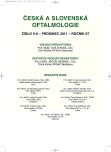Posterior Capsule Opacification in Long-term Follow-up of Patients after Implantation of Hydrophilic / Hydrophobic Intraocular Lens Acri.Smart
Authors:
M. Černák 1; A. Černák 1; V. Siska 1; J. Nekorancová 1; P. Krajčová 2
Authors‘ workplace:
Očná klinika LF SZU, UNB, Nemocnica sv. Cyrila a Metoda, Bratislava
prednosta prof. MUDr. Andrej Černák, DrSc.
1; Očná klinika LF UK, UNB, Nemocnica Ružinov, Bratislava
prednosta prof. MUDr. Peter Strmeň, CSc.
2
Published in:
Čes. a slov. Oftal., 67, 2011, No. 5-6, p. 147-149
Category:
Original Article
Overview
Aim:
The aim of the retrospective study was to establish the frequency of the posterior lens capsule opacification after the cataract surgery and artificial intraocular lens (IOL) Acri.Smart 46S (Acri.Tech Zeiss) implantation.
Material and methods:
The study group consisted of 72 eyes (30 men and 28 women), their average age was 65.4 ± 8.4 years, with performed cataract surgery and implanted IOL Acri.Smart 46S (Acri.Tech Zeiss). After the average period of 32.4 ± 7.3 months after the surgery, the patients underwent the examination with refractive error measurement, uncorrected and best-corrected visual acuity for far, and posterior lens capsule transparency examination with dilated pupils and with retroillumination photography taken by NIDEK EAS-100 device.
Results:
After the average follow-up period of 32.4 ± 7.3 months after the surgery, the refractive error was –0.32 ± 0.8 diopters and average cylindrical error –0.8 ± 0.6 Dcyl. The uncorrected visual acuity (UCVA) was 0.72 ± 0.3, and the best-corrected visual acuity (BCVA) 0.95 ± 0.2. The average diameter of the examined posterior capsule was 5.89 ± 2.1 mm, and the transparency of the posterior capsule was 98.41 ± 8.5 %. In two eyes (2.7 %) only, the YAG capsulotomy was performed.
Conclusion:
The IOL Acri.Smart is safe, easy to implant IOL, which meets the requirements of the microincision surgery. The IOL had very low incidence of posterior lens capsule opacification, and in two eyes (2.7 %) only the YAG capsulotomy was performed.
Key words:
Secondary cataract, hydrophobic intraocular lens, hydrophilic intraocular lens, square edge, YAG capsulotomy
Sources
1. Alio, JL, Rodriguez – Prats, JL, Vianello, A., et. al.: Visual outcome of microincision cataract surgery with implantation of an Acri. Smart lens. J. Cataract Refract Surg. 2005; 31: 1549–1556.
2. Apple, DJ, Solomon, KD, Tetz, MR, et al.: Posterior capsular opacification. Surv Ophthalmol. 1992; 37: 73–113.
3. Aufarth GU, Brezin A, Caporossi A, et al.: Comparison of Nd: YAG capsulotomy rates following phacoemulsification with implantation of PMMA silicone or acrylic intraocular lenses in four European countries. European PCO Study Group. Ophthalmic Epidemiol. 2004; 11: 319–329.
4. Baráková, D, Kuchynka, P., Klečka, D.: Srovnání frekvence sekundární katarakty u silikonových a PMMA čoček = Comparison of the frequency of secondary cataract in silicone and PMMA lenses, Čes a Slov Oftalmol. 1998; 4: 246–249.
5. Davidson, JA.: Neodynium: YAG laser posterior capsulotomy after implantation of AcrySof intraocular lenses. J Cataract Refract Surg. 2004; 30: 1492–1500.
6. Findl, O, Menapace, R, Sacu, S, et al.: Effect of optic material on posterior capsul opacification in intraocular lenses with sharpedges optics, randomizes clinical trial. Ophthalmology 2005; 112: 67–72.
7. Hancox, J, Spalton, D, Heatley, C, et al.: Fellow –eye comparison of posterior capsule opacification rates after implantation of ICU accommodativy and AcrySoft MA 30 monofocal intraocular lenses. J Cataract Refract Surg. 2007; 33: 413–417.
8. Heathely, CJ, Spalton, DJ, Komar, A, et al.: Comparison of posterior capsule opacification rates between hydrophilic and hydrophobic single – piece acrylic intraocular lenses. J Cataract Refract Surg. 2005; 31: 718–724.
9. Hollick, EJ, Spalton, DJ Ursell, PG, et al.: The effect of polymethyl – methacrylate, silicone, and polyacrylic intraocular lenses on posterior capsular opacification 3 years after cataract surgery. Ophthalmology 1999; 106: 49–54.
10. Jirásková, N., Rozsíval, P., Kohout, A.: Opacifikace hydrofilních akrylátových nitroočních čoček, Čes. a slov. Oftal. 2007; 63, 390–395.
11. Khandwala, MA, Marjanovic, B, Kotagriri, AK, et al.: Rate of posterior capsule opacification in eyes with the Akeros intraocular lens. J Cataract Refract Surg. 2007; 33: 1409–1413.
12. Krajčová, P., Chynoranský, M, Strmeň, P.: Opacifikácia zadného puzdra šošovky po implantácii rôznych typov umelých vnútroočných šošoviek, Čes. a Slov. Oftal. 2007; 63: 379–389.
13. Kruger, AJ, Schanersberger, J, Abela, C, et al.: Two year results sharp versus rounded optic edges on silicone lenses. J Cataract Refract Surg. 2000; 26: 566–570.
14. Kugelberg, M, Wejde, G, Jayaram, H, et al.: Posterior capsule opacification after implantation of hydrophilic or a hydrophobic acrylic lens. One-year follow up. J Cataract Refract Surg. 2006; 32: 1627–1631.
15. Meacock, WR, Spalton, DJ, Boyce, JF, et al.: Effect of optic size on posterior capsule opacification: 5.5 mm versus 6.0 mm AcrySof intraocular lenses. J Cataract Refract Surg. 2001; 27: 1194–1198.
16. Menapace, R.: Sharp-edged IOLs, ESCRS-Eurotimes, 2010, 15: 12–13.
17. Nishi, O, Nishi, K, Akura J.: Speed of capsular bend formation at the optic edge of acrylic, silicone and poly (methyl mathacrylate) lenses. J Cataract Refract Surg. 2002; 28: 431–437.
18. Nishi, O, Nishi, K., Osakabe, Y.: Effect of intraocular lenses on preventive posterior capsule opacification : design versus material. J Cataract Refract Surg. 2004; 30: 2170–2176.
19. Prosdocimo, G, Tassinari, G, Sala, M, et al.: Posterior capsular opacification after phacoemulsification. J Cataract Refract Surg. 2003; 29: 1551–1555.
20. Ursell, PG, Spalton, DJ, Pande MV, et al.: Relationship between intraocular lens biomaterials and posterior capsular opacification. J Cataract Refract Surg. 1998; 24: 352–360.
Labels
OphthalmologyArticle was published in
Czech and Slovak Ophthalmology

2011 Issue 5-6
Most read in this issue
- Comparison of Keratometric Values and Corneal Eccentricity of Myopia, Hyperopia and Emmetropia
- Minimal Ocular Findings in a Patient with Best Disease Caused by the c.653G>A Mutation in BEST1
- AquaLase Method – Influence to the Secondary Cataract Appearance and its Safety
- Suprachoroid Hemorrhage without the Connection to the Surgical Procedure
